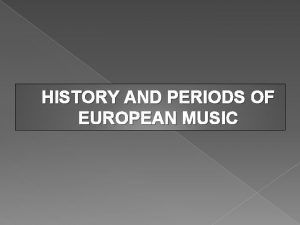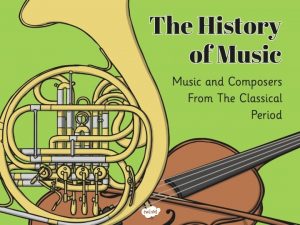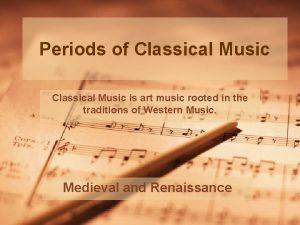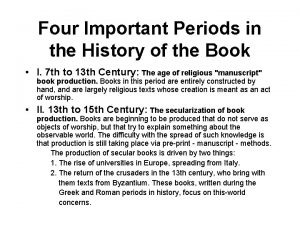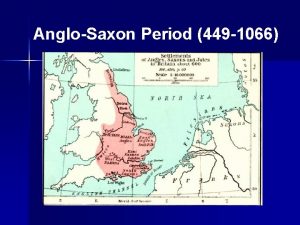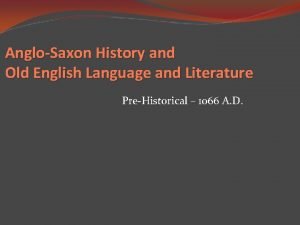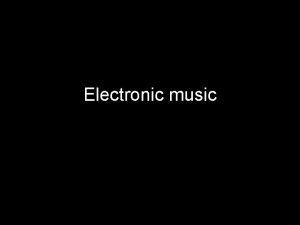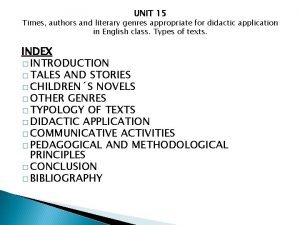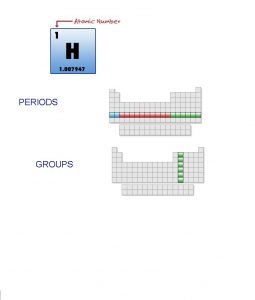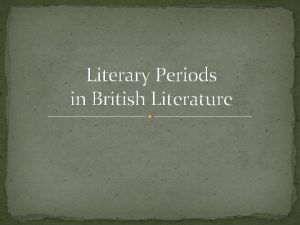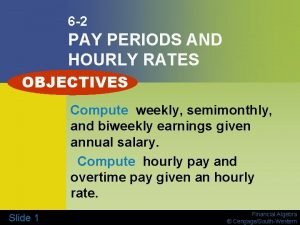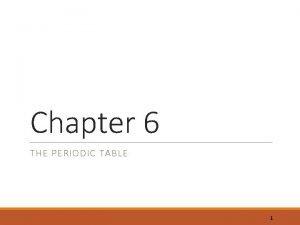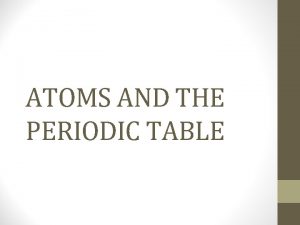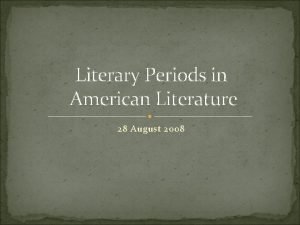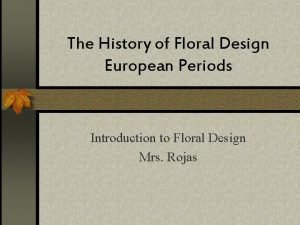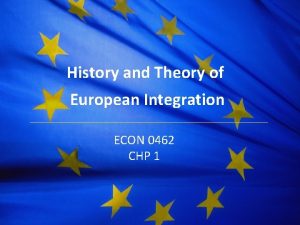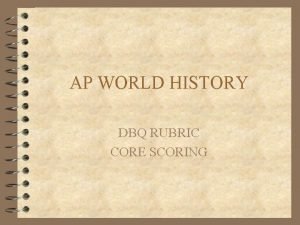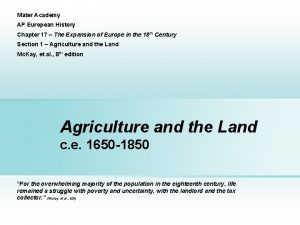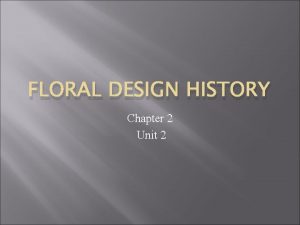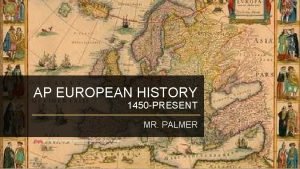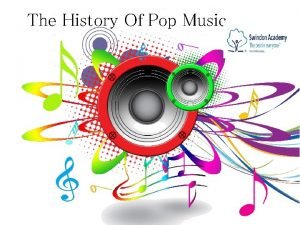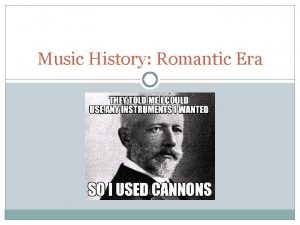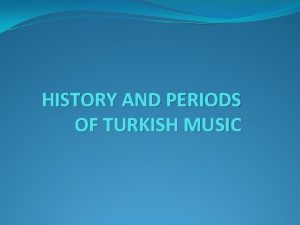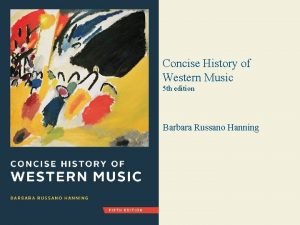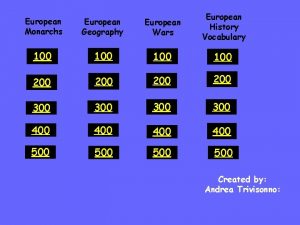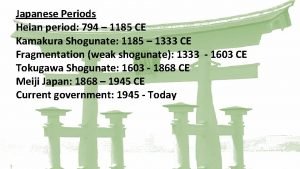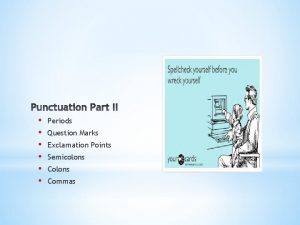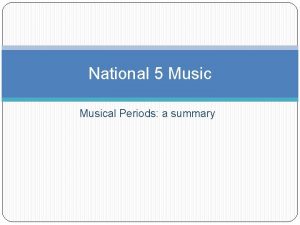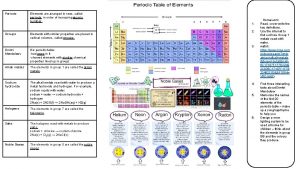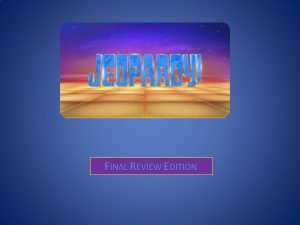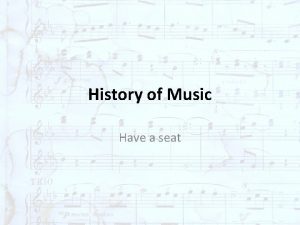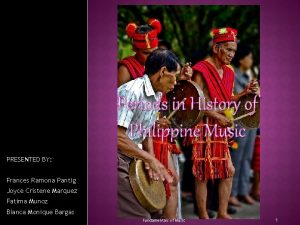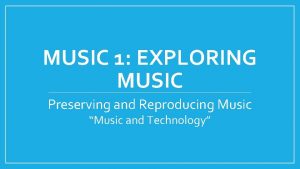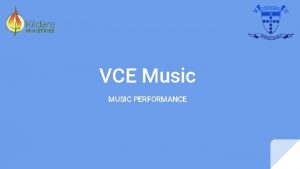HISTORY AND PERIODS OF EUROPEAN MUSIC HISTORY OF









































- Slides: 41

HISTORY AND PERIODS OF EUROPEAN MUSIC

HISTORY OF MUSIC

� The major time divisions of classical music up to 1900 are the early music period, which includes Medieval (500– 1400) and Renaissance (1400– 1600) eras, and the Common practice period, which includes the Baroque (1600– 1750), Classical (1750– 1830) and Romantic (1804– 1910) eras. Since 1900, classical periods have been reckoned more by calendar century than by particular stylistic movements that have become fragmented and difficult to define.

� The 20 th century calendar period (1901– 2000) includes most of the early modern musical era (1890– 1930), the entire high modern (mid 20 th-century), and the first 25 years of the contemporary or postmodern musical era (1975–current). The 21 st century has so far been characterized by a continuation of the contemporary/postmodern musical era.


� The dates are generalizations, since the periods and eras overlap and the categories are somewhat arbitrary, to the point that some authorities reverse terminologies and refer to a common practice 'era' comprising baroque, classical, and romantic 'periods

�. Beethoven, who is often described as a founder of the Romantic era, and Brahms, who is classified as Romantic, also used counterpoint and fugue, but other characteristics of their music define their era


ANCIENT MUSIC � Burgh (2006), suggests that the roots of Western classical music ultimately lie in ancient Egyptian art music via cheironomy and the ancient Egyptian orchestra, which dates to 2695 BC.

� The development of individual tones and scales was made by ancient Greeks such as Aristoxenus and Pythagoras created a tuning system and helped to codify musical notation.

� Ancient Greek instruments such as the aulos (a reed instrument) and the lyre (a stringed instrument similar to a small harp) eventually led to the modern-day instruments of a classical orchestra.

Medieval music � Many of the instruments used to perform medieval music still exist, but in different forms. Medieval instruments included the wood flute (which in the 2000 s is made of metal), the recorder and plucked string instruments like the lute.

�. Medieval instruments in Europe had most commonly been used singly, often self accompanied with a drone note, or occasionally in parts.

� Polyphonic vocal genres, which used multiple independent vocal melodies, began to develop during the high medieval era, becoming prevalent by the later 13 th and early 14 th.

Renaissance music � Many instruments originated during the Renaissance; others were variations of, or improvements upon, instruments that had existed previously.

� As in the modern day, instruments may be classified as brass, strings, percussion, and Stringed instruments included the viol, the harp-like lyre, the hurdy-gurdy, the cittern and the lute. .

�. Vocal music in the Renaissance is noted for the flourishing of an increasingly elaborate polyphonic style. . Towards the end of the period, the early dramatic precursors of opera such as monody, the madrigal comedy, and the intermedio are seen.


Baroque music � Baroque instruments included some instruments from the earlier periods (e. g. , the hurdy-gurdy and recorder) and a number of new instruments (e. g, the cello, contrabass and fortepiano).

� Keyboard instruments included the clavichord, tangent piano, the fortepiano (an early version of the piano), the harpsichord and the pipe organ.


� One major difference between Baroque music and the classical era that followed it is that the types of instruments used in ensembles were much less standardized.

� Vocal developments in the Baroque era included the development of opera types such as opera seria and opéra comique, oratorios, cantatas and chorale.

CLASSICAL MUSIC � The term "classical music" has two meanings: the broader meaning includes all Western art music from the Medieval era to the 2000 s, and the specific meaning refers to the music from the 1750 s to the early 1830 s– the era of Mozart and Haydn.

� The Classical era stringed instruments were the four instruments which form the string section of the orchestra: the violin, viola, cello and contrabass.

� Brass instruments included the buccin, the ophicleide (a serpent replacement which was the precursor of tuba) and the natural.


� The composer's instrumentation usually included paired flutes, oboes, clarinets, bassoons, horns and trumpets.

�. Piccolo, contrabassoon, and trombones add to the triumphal finale of his Symphony No. 5. A piccolo and a pair of trombones help deliver "storm" and "sunshine" in the Sixth.

� For several decades after he died, symphonic instrumentation was faithful to Beethoven's well-established model, with few exceptions.


Romantic music � In the Romantic era, the modern piano, with a more powerful, sustained tone and a wider range took over from the more delicatesounding fortepiano.

� Saxophones appear in some scores from the late 19 th century onwards. While appearing only as featured solo instruments in some works, for example Maurice Ravel's orchestration of Modest Mussorgsky's Pictures at an Exhibition and Sergei Rachmaninoff's Symphonic Dances, the saxophone is included in other works, such as Ravel's Boléro, Sergei Prokofiev's Romeo and Juliet Suites 1 and 2 and many other works as a member of the orchestral ensemble.

� The euphonium is featured in a few late Romantic and 20 th-century works, usually playing parts marked "tenor tuba", including Gustav Holst's The Planets, and Richard Strauss's Ein Heldenleben.

MODERN ERA � Electric instruments such as the electric guitar, the electric bass and the ondes Martenot appear occasionally in the classical music of the 20 th and 21 st centuries.

� Many instruments today associated with popular music filled important roles in early classical music, such as bagpipes, vihuelas, hurdy-gurdies, and some woodwind instruments.

MUSIC EDUCATION � During the 1990 s, several research papers and popular books wrote on what came to be called the "Mozart effect": an observed temporary, small elevation of scores on certain tests as a result of listening to Mozart's works.

� This popularized version of theory was expressed succinctly by the New York Times music columnist Alex Ross: "researchers. . . have determined that listening to Mozart actually makes you smarter.

� In 1996– 1997, a research study was conducted on a large population of middle age students in the Cherry Creek School District in Denver, Colorado, USA. The study showed that students who actively listen to classical music before studying had higher academic scores.

� The research further indicated that students who listened to the music prior to an examination also had positively elevated achievement scores. Students who listened to rock-and-roll or country had moderately lower scores. The study further indicated that students who used classical during the course of study had a significant leap in their academic performance; whereas, those who listened to other types of music had significantly lowered academic scores.

GTO FINE ARTS HIGH SHOOL 2016
 Music history periods
Music history periods Online music portfolio
Online music portfolio European literature periods
European literature periods Periods of music
Periods of music The approximate dates of the baroque period in music are
The approximate dates of the baroque period in music are Music periods timeline
Music periods timeline Time periods of music
Time periods of music Western music periods
Western music periods Periods in roman history
Periods in roman history Four periods of history
Four periods of history Phoenician alphabet is what computing periods?
Phoenician alphabet is what computing periods? 3 periods of history
3 periods of history 3 periods of history
3 periods of history Romantic period instrument
Romantic period instrument Beats organized in a recurring accent pattern
Beats organized in a recurring accent pattern What music that employs electronic music
What music that employs electronic music Ilocano instruments
Ilocano instruments Topic 15 periods authors and genres
Topic 15 periods authors and genres Pay periods and hourly rates
Pay periods and hourly rates Groups and periods
Groups and periods British literary eras
British literary eras 6-2 pay periods and hourly rates
6-2 pay periods and hourly rates Groups and periods
Groups and periods Nucleus on the periodic table
Nucleus on the periodic table Plural of letters and numbers
Plural of letters and numbers Hair alternates between periods of growth and rest
Hair alternates between periods of growth and rest Characteristics of american literature periods
Characteristics of american literature periods European floral design history
European floral design history European union history
European union history Renaissance floral design history
Renaissance floral design history Discuss the art of emerging europe
Discuss the art of emerging europe Ap dbq rubric
Ap dbq rubric Egyptian flower design
Egyptian flower design Ap european history chapter 17
Ap european history chapter 17 Is poland considered eastern europe
Is poland considered eastern europe French floral design history
French floral design history Palmer european history
Palmer european history History of pop
History of pop The deliberate intent to draw creative inspiration
The deliberate intent to draw creative inspiration Turkish music history
Turkish music history Examples of tagalog sarsuela
Examples of tagalog sarsuela Concise history of western music 5th edition
Concise history of western music 5th edition
